Google Analytics 4 (GA4) replaced Universal Analytics—officially shutting UA down in 2024. You only need to glance at the r/GoogleAnalytics subreddit to see how well users have taken the change.
While Google promised better measurement capabilities, marketers and data analysts quickly saw drawbacks. These included more complexity, limited multi-touch attribution, and concerns over data privacy and usability.
If you want clearer marketing and ROI insights, exploring GA4 alternatives can be a smart strategy. In this guide, we review six leading analytics tools to help you make the best choice, including:
- The Attribution Platform
- Matomo
- Fathom
- Piwik Pro
- Plausible
- Clicky
Key Takeaways:
- The shift from UA to GA4 has highlighted significant gaps in attribution and privacy compliance. This has pushed teams to look for alternatives.
- Analytics alternatives range from comprehensive enterprise solutions to lightweight privacy-focused tools, each offering advantages for different needs.
- A successful transition from GA4 requires thorough planning around data preservation, implementation strategy, and team training to keep up insight continuity.
Why Look For GA4 Alternatives?
While GA4 includes updated data privacy features and promises extra insights powered by AI, there are several challenges you’ve likely experienced that are the reason you’re looking for alternatives, including:
- Steep learning curve: GA4’s intricate interface makes it difficult for users accustomed to UA to adapt quickly.
- Limited multi-touch attribution: GA4 primarily utilizes last-click models and lacks robust multi-touch options, failing to capture the complexity of the user journey.
- Privacy and data transparency concerns: Businesses have expressed discomfort around Google’s use and storage of data, especially where compliance (GDPR, CCPA) is crucial.
- Weak revenue attribution: GA4 struggles in directly linking marketing spend to real revenue outcomes, forcing marketers into convoluted analyses.
- Cross-device tracking challenges: GA4 inadequately manages fragmented user journeys involving multiple devices or browsers.
These limitations hinder your ability to confidently measure ROI and justify budgets, highlighting the need for alternative analytics platforms.
Key Capabilities To Look For In A GA4 Alternative
When you’re looking for an alternative solution, it’s important to prioritize capabilities that match with your specific marketing goals. Here are key criteria you should be on the lookout for:
- Multi-touch attribution: Advanced attribution modeling to track each interaction and accurately assign credit to multiple touchpoints in the buyer journey.
- Ease of use: User-friendly dashboards, custom reporting, and smooth interfaces to avoid team adoption hurdles.
- Privacy compliance: Strong measures for adhering to GDPR, CCPA, and other global regulations around data handling.
- Real-time data processing: Immediate analysis and reporting so you can take action without delay.
- Cross-channel integrations: Seamless interaction across all marketing platforms like Google Ads, social media, email, and CRMs.
- Cost effectiveness: Evaluate pricing transparency and implementation complexity based on your company size and requirements.
Some tools we’ll cover below are better suited to particular use cases and favor some of the above criteria over others.
6 Best Google Analytics 4 Alternatives
Below we walk through the top alternatives to GA4 and which situation and use case each tool is suited for.
1. The Attribution Platform: A Comprehensive Multi-Touch Attribution Alternative
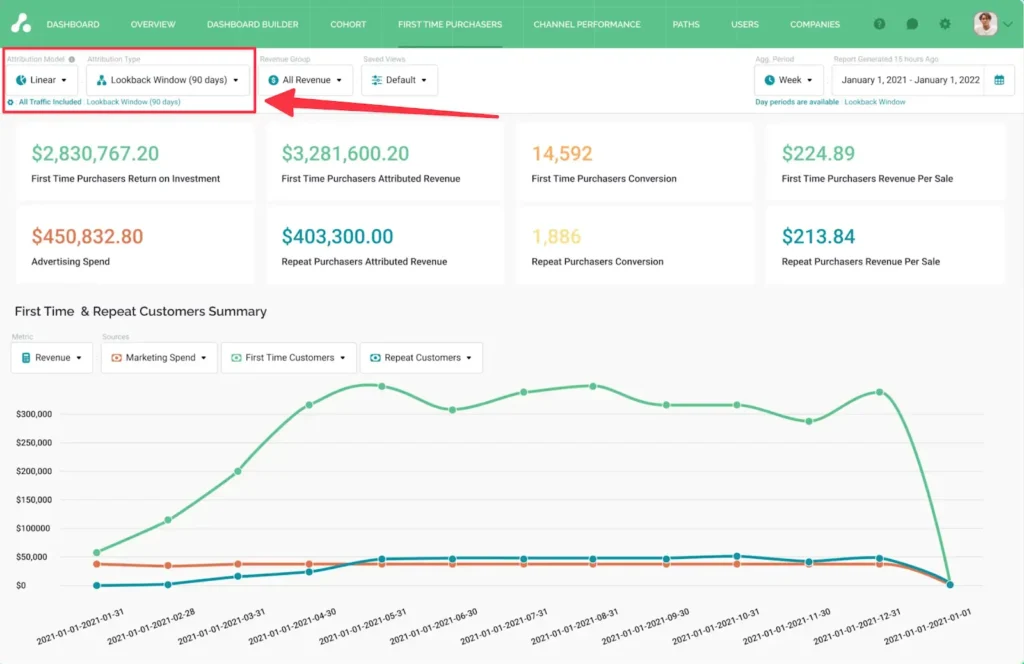
The Attribution Platform stands out for marketers looking for advanced multi-touch and lead attribution.
Unlike GA4, it delivers clear full-funnel visibility from the initial touchpoint to final conversion, offering true ROI metrics rather than vague engagement figures. Its major strengths include:
- Comprehensive multi-touch models across full user journeys.
- Clear ROI visibility directly tied to ad spend.
- Transparent attribution demonstrates exactly which marketing touchpoints influenced revenue.
- Integration with major platforms (Google Ads, Facebook, LinkedIn).
- Machine learning tools that refine insights over time.
The features that The Attribution Platform offers directly address the major issues of GA4’s limitations, including:
- Replacing its limited attribution modeling with comprehensive journey analysis.
- Providing clear ROI metrics.
- Offering intuitive dashboards that simplify complex data for you.
Addressing these concerns is not to say that GA4 is useless. It’s a good data source and is complementary to platforms that can integrate its data for better, easier use.
The Attribution Platform is an ideal solution for data-driven teams, multi-channel advertisers, and ROI-focused organizations.
Book a Demo
Understand the precise impact of each marketing touchpoint and track “true” CAC, ROAS, and ROI on marketing spend with The Attribution Platform.
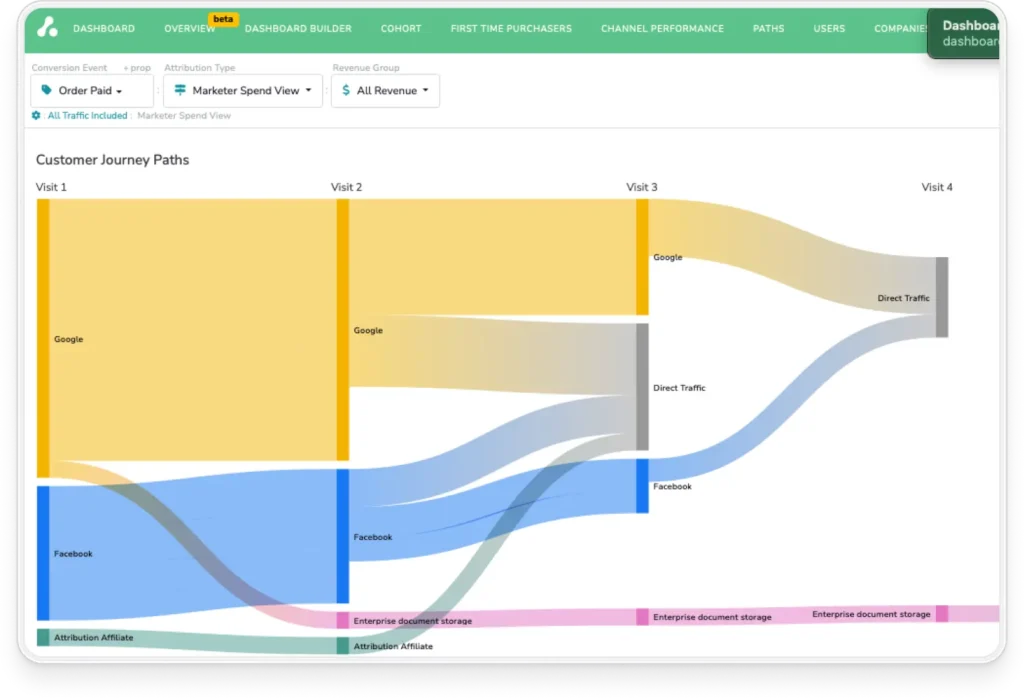
2. Matomo: The Open-Source GA4 Alternative
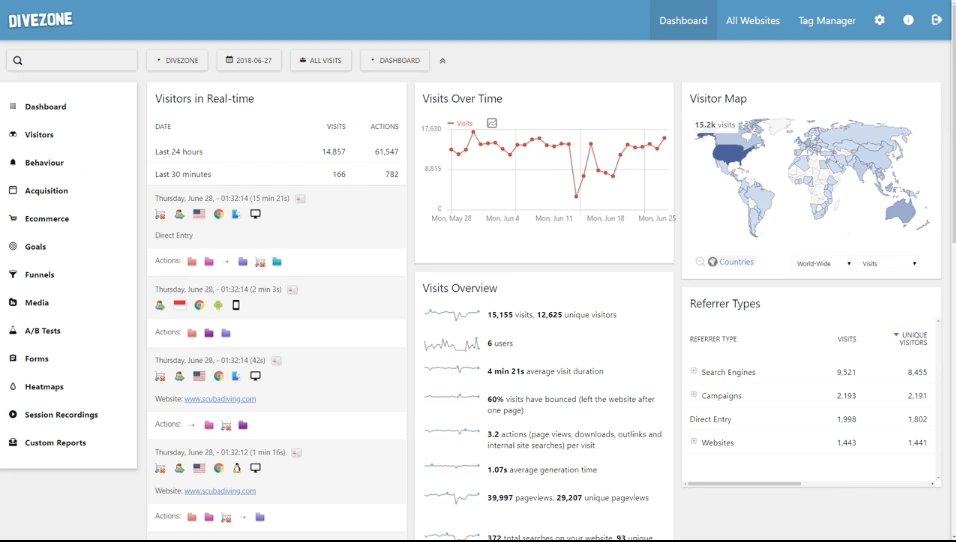
Image source: Matomo
Matomo provides an open-source analytics alternative that emphasizes user privacy and data ownership. It supports GDPR guidelines closely and caters to organizations seeking compliance and transparency, with hosting options on-premise or cloud-based.
Key features include:
- Complete data ownership (hosting data in-house or via a trusted cloud service).
- Strong GDPR and privacy compliance.
- A clean, intuitive interface similar to Universal Analytics.
Matomo suits mid-sized businesses, governmental agencies, and privacy-focused enterprises, although it’s less robust in multi-touch capabilities compared to specialized attribution tools. But it’s worth noting that for the on-premises hosting, you’ll need significant technical expertise to set it up.
Pricing:
Matomo’s pricing is a little confusing:
- Cloud-based analytics plan from $29/month, or custom Enterprise pricing.
- Free for on-premises hosting, but separate annual pricing for premium features.
3. Fathom: A Simplicity-Focused GA4 Alternative
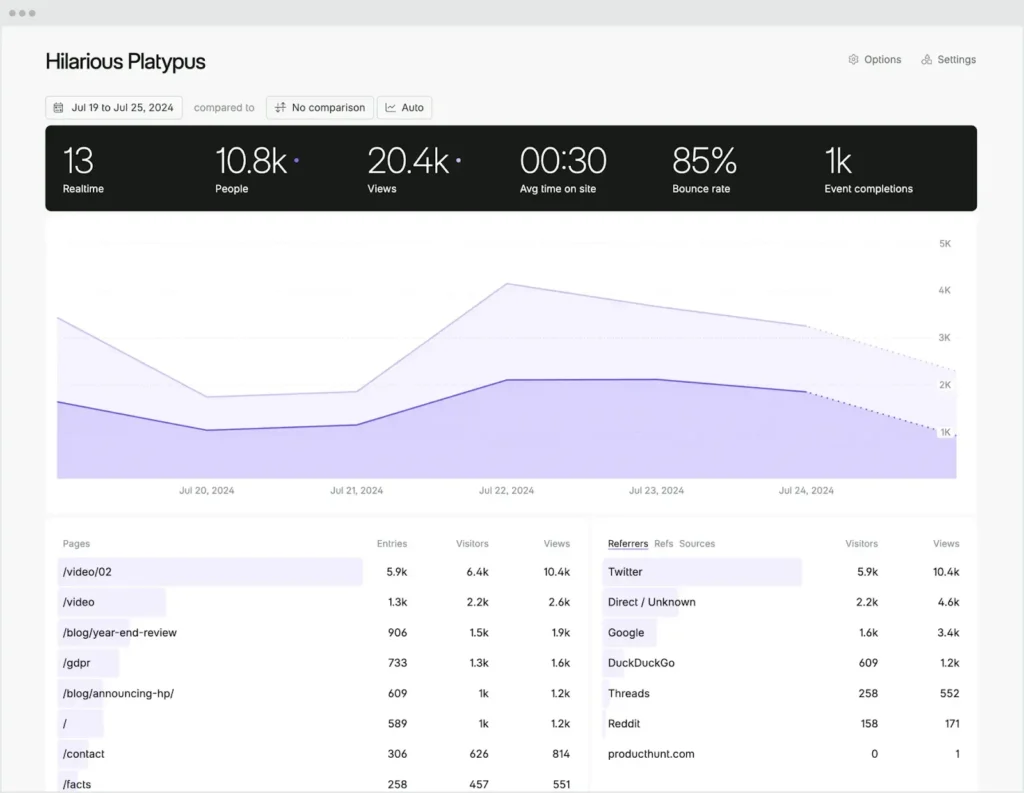
Image source: Fathom
Fathom Analytics offers an excellent GA4 alternative for businesses favoring straightforward analytics without complexity. Its lightweight, cookieless design delivers basic, clear metrics while preserving site speed and visitor privacy.
Main highlights:
- Quick setup with minimal technical knowledge needed.
- Highly privacy-compliant (GDPR, CCPA), this removes the need for cookie consent banners.
- An intuitive dashboard with real-time visitor and conversion stats.
Fathom’s simplicity makes it a go-to option for small businesses, bloggers, and individuals prioritizing privacy and straightforward metrics. However, it has limited advanced reporting capabilities, fewer integrations compared to other tools, and only basic attribution modeling (last-touch).
Pricing:
Starts from $15/month (or $150/year), increases based on monthly data points.
4. Piwik PRO: Enterprise-Grade GA4 Alternative
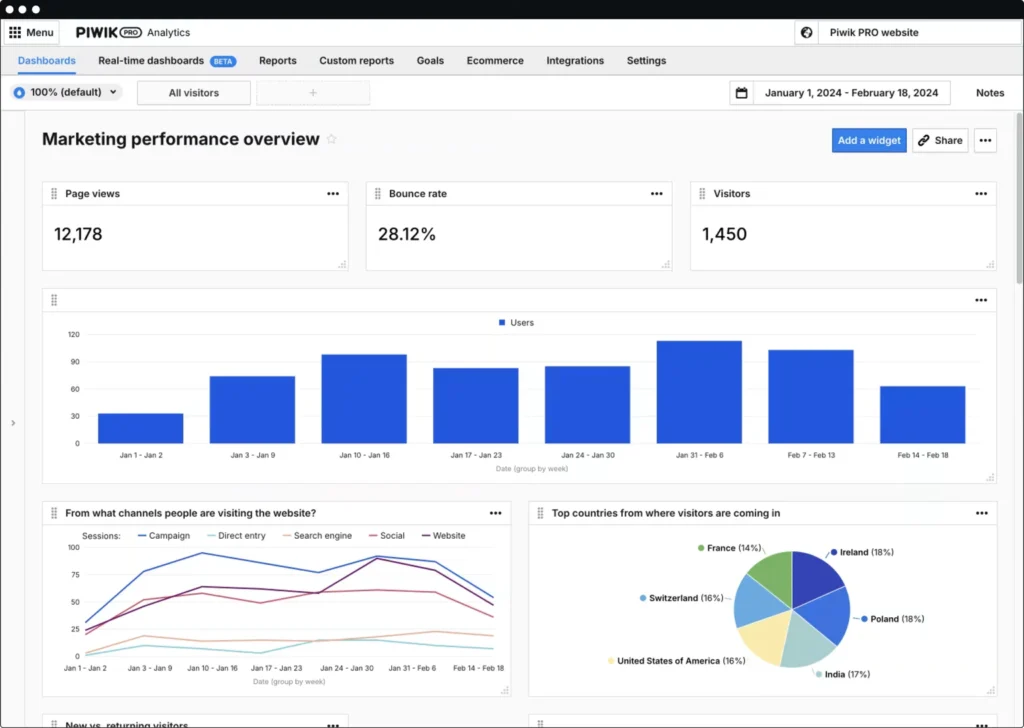
Image source: Piwik Pro
For enterprises with rigorous data compliance and analytics demands, Piwik PRO provides a robust GA4 alternative. Originally based on Matomo but redesigned for enterprise needs, it ensures advanced compliance and privacy controls alongside scalable capabilities.
Primary benefits include:
- Advanced tag management and consent management system.
- Sophisticated privacy compliance tools (ideal for GDPR-heavy use cases).
- Flexible deployment (cloud-based or on-premise).
- Better attribution capabilities than simpler analytics solutions.
These features offer more than its original Matomo form, but it’s still not as comprehensive in authentic multi-touch attribution as specialized platforms. It’s also more complex to implement and has a much higher price point than other tools.
Piwik Pro is more suitable for regulated industries and large organizations where compliance needs supersede granular marketing attribution.
Pricing:
- Free plan available (up to 500,000 monthly actions), you can separately purchase up to 5M actions.
- Enterprise plan: Starting from €10,995/year (tiers from 2M actions to 4B actions).
5. Plausible: Lightweight GA4 Alternative
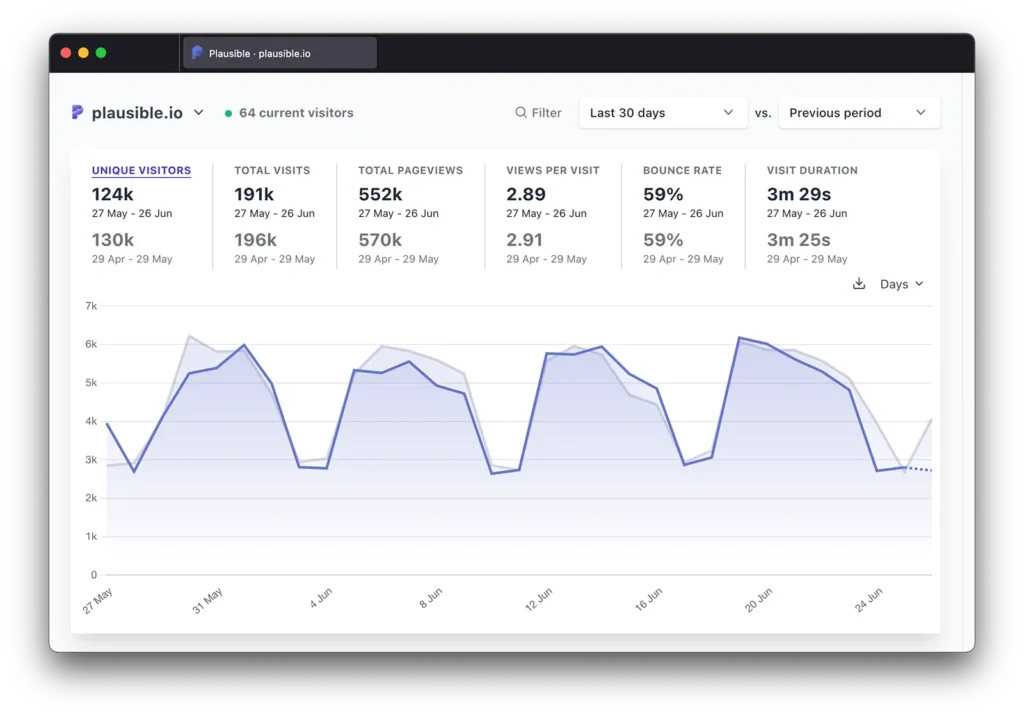
Image source: Plausible
Plausible Analytics focuses heavily on user simplicity and privacy protection. It provides a streamlined GA4 alternative for smaller sites and blogs. Notable features include:
- Minimalistic, intuitive dashboard with essential metrics.
- Ultra-lightweight script ensuring fast site performance.
- Cookieless tracking is fully compliant with GDPR and other privacy regulations.
- Affordable pricing adaptable to small budgets.
Plausible is a strong candidate for small websites, independent creators, and privacy-conscious businesses because of its simplicity and commitment to privacy. But similarly to Fathom, it doesn’t have as much advanced reporting capabilities, only basic attribution modeling, and fewer integrations compared to other tools.
Pricing:
Plausible pricing is based on tiers and monthly pageviews (they have a calculator for calculating pageview costs):
- Growth: Starts at $9/month (or $90/year) up to 10K pageviews, 3 team members, 10 sites, 3 years of data retention.
- Business: Starts at $19/month (or $190/year) up to 10K pageviews, 10 team members, 50 sites, 5 years of data retention.
6. Clicky: Real-Time Focused GA4 Alternative
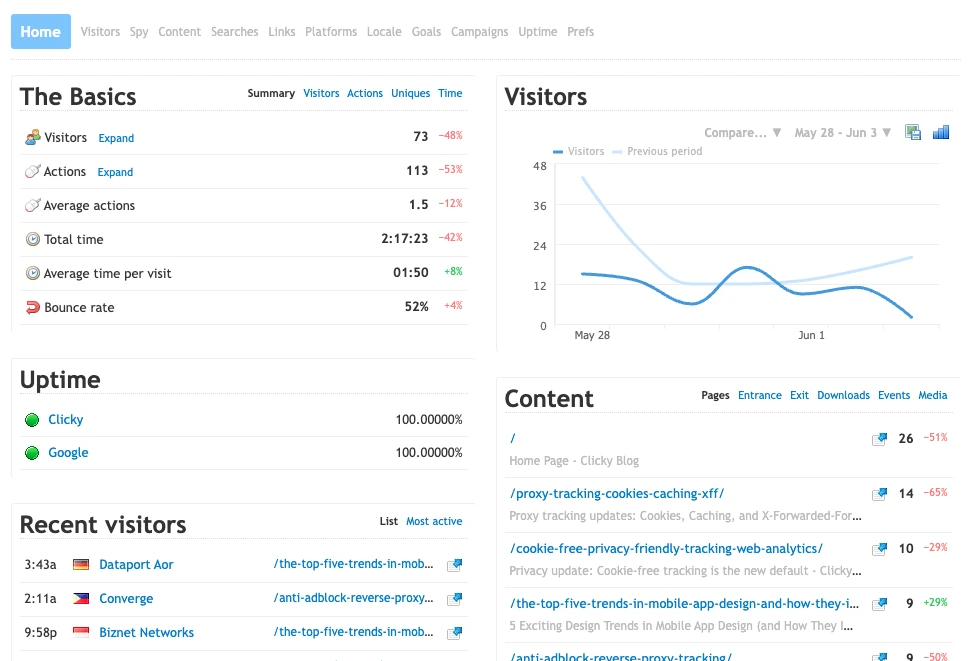
Clicky distinguishes itself through granular, real-time data tracking. It’s particularly suitable for small-to-medium businesses and content-driven websites, its core strengths include:
- Live data tracking to immediately identify visitor behavior and website performance.
- Heatmaps and visitor session recordings for detailed UX insights.
- Basic uptime monitoring and integration for small business needs.
- Twitter (X) analytics integration.
While limited compared to more robust analytics suites in multi-touch attribution or enterprise integration, Clicky effectively supports smaller businesses and content-focused websites that prioritize immediate data insights.
Pricing:
Clicky pricing is based on five tiers, each increasing website and daily pageview allowances:
- Free plan available—1 site, 3,000 daily pageviews.
- Pro: $9.99/month (or $79.99/year)—10 sites, 30K daily pageviews.
- Pro Plus: $14.99/month (or $119.99/year)—same as Pro, but adds Heatmaps and uptime monitoring.
- Pro Platinum: $19.99/month (or $159.99/year)—30 sites, 100K daily pageviews.
- Custom: Contact for pricing.
Best Practices For Transitioning From GA4 To An Alternative
If you’ve already been using Google Analytics 4 since its release, you’ll have likely built up a lot of data you don’t want to lose. This might make you hesitate on change in the first place.
Switching can still be worth it, but to make the transition a little easier, follow these best practices.
Audit Your Current Analytics Needs
Before you decide on an alternative tool, you should take stock of what essential metrics and reports you currently use in GA4. Clearly define them alongside your attribution needs.
After you’ve figured out the essential parts you do use, identify the current GA4 gaps you need filled by new software. Do you need particular types of PPC reporting? Do you need more functionality between GA4 and Shopify?
Each gap you identify helps you create and prioritize a list of “must-have” against “nice-to-have” requirements for you to clarify suitable alternatives.
Plan For Data Continuity
If you don’t want to lose your historical data, you need to plan for data preservation and continuity. You should look for alternatives that have a GA4 integration, or at least a data import option. The other option is to look for long-term data storage that’s separate from your other tools (but this option isn’t preferable since it becomes a data silo).
For data continuity options, you should run parallel implementations during the transition period to make sure you’re getting reliable data sets and reporting insight continuity.
As you transition between tools, also keep documentation of key metric definitions to make sure your reporting is consistent for historical comparisons.
Implementation Considerations
When you start implementing a new solution, you’ll need to work carefully with your technical team to deploy new tracking codes, tags, and event setups accurately.
As you transition to your new tool, make sure you conduct extensive testing to validate correct data capture before completely switching from GA4 (if you don’t want to keep it).
Another factor to consider is team training. As you’re implementing the tool, it’s a good idea to conduct a training workshop, or create a small library of resources (like documentation and/or a video series) to help your team adapt to the new tool. Regularly revisit the documentation to make sure definitions and data handling is consistent.
Measuring Success Post-Transition
Before you completely transition to a new solution, make sure you have set clear baseline metrics to help you measure improvements in accuracy, attribution clarity, and ease-of-use post-transition.
Then, when you’ve officially switched tools, regularly conduct validation checks to avoid data inaccuracies or inconsistencies during the early adoption stages.
Remember, you’re probably switching tools for better analytical capabilities. Make sure you maximize the new platform’s features to help you gain insights that go beyond what you could get before with GA4 alone.
Gain Deeper Insights From a GA4 Alternative
The problems that GA4 presents its users have pushed them into exploring more efficient or feature-forward analytics options. We’ve shown you a few popular alternatives that each offer unique strengths, from robust multi-touch, full-funnel attribution solutions like The Attribution Platform, to simpler, privacy-focused tools like Fathom and Plausible.
Choosing the right alternative for you depends on your exact attribution needs, privacy concerns, budget, and technical capacity.
Whichever tool you choose, clear attribution insights will directly improve your marketing operations, allowing for more confident decision-making and demonstrating true ROI.
For marketers that are prioritizing comprehensive, revenue-driven multi-touch attribution, The Attribution Platform offers the most complete, intuitive choice to replace or complement GA4.
Sign up and try Attribution today — pinpoint CAC by channel, audit funnels and conversion rates, scale revenue-driven content marketing, measure affiliate LTV and CAC (and more).
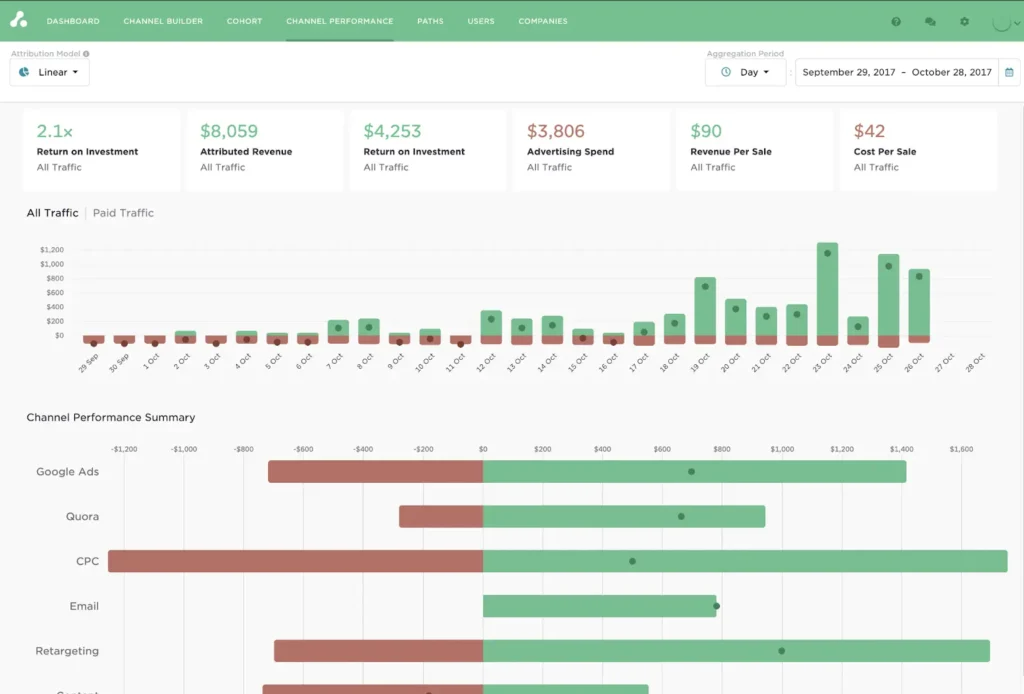
GA4 Alternatives FAQ
Which GA4 alternative is best for real-time analytics and multi-touch attribution?
The Attribution Platform provides the most complete multi-touch attribution features, accurately linking marketing investments to revenue results across the full customer journey.
How do GA4 alternatives handle privacy compliance?
Most GA4 alternatives prioritize user data protection and compliance. They offer features like cookieless tracking, explicit consent management, and transparent data handling policies that align with GDPR and CCPA.
What’s the difference between last-click and multi-touch attribution models?
Last-click attribution credits conversions only to the final interaction before purchase, overlooking earlier touchpoints. Multi-touch attribution distributes credit across all customer interactions, providing a more comprehensive view of the buyer’s journey.
How difficult is it to migrate from GA4 to an alternative platform?
Migration complexity varies based on your chosen alternative. To minimize risk and maintain data integrity during the transition, critical steps include thorough planning, capturing historical data, careful deployment, and parallel testing.
